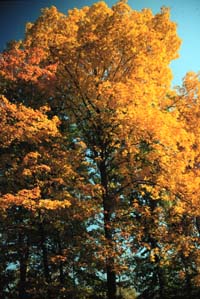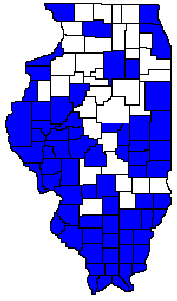 |
| Pignut
Hickory (Carya glabra)
Distribution
Map to Right |

Pignut hickory (Carya glabra) is also commonly referred to as sweet pignut. It is slow growing, medium to tall tree typically reaching 60 to 80 feet in height. It has a straight trunk, which sometimes branches close to the ground, and an oblong crown. It is present throughout almost all of Illinois, most frequently on wooded slopes.
Interesting
Facts
The hickories
are divided into three groups comprised of the pecans (four species), the
shagbarks (three species), and the pignuts (four species). The pignuts
are distinguished from the other groups by their tight bark (not as shaggy
as the shagbark hickory), slender twigs, thin nut husks, and smaller buds.
Pignut hickory reproduces by seed and by stump sprouts. The seedlings do
not tolerate shade very well, and require a gap or sufficient sunlight
to survive over long periods.
Identifying Features
Bark
The bark is gray and smooth when the tree is young. As the tree ages, the bark peels off into narrow strips, but these are not as extensive or curling as in shagbark hickory (Carya ovata).
Twigs
The twigs are reddish, brown, slender and usually smooth.
Buds
The terminal (at the end of the twig) buds are relatively small, hairy edged, brown with tiny yellow dots, and rounded with a short point at the tip.
Leaves
Pignut hickory leaves are 6 to 12 inches long, alternate, and pinnately compound with 5 to 7 leaflets. The leaflets are finely toothed, smooth, lance-shaped, pointed at the tip and tapering at the base. They are green on the upper surface and may be dotted and have hairs on the underside.
Flowers
Male (staminate) and female (pistillate) flowers are borne separately, but on the same tree (monoecious), and appear after leaf out. As with the other hickories, the flowers appear as drooping catkins (spike-shaped flowers, usually drooping, that bear only male or female parts and eventually fall entire from the tree. Catkins occur only in woody plants).
Fruits
The fruits are egg-shaped and 1/2 to 1 1/4 inches long. The nut husks are brown, somewhat warty, and split into four sections as in the shagbark, but are much thinner shelled than in the shagbark hickory. The pignut hickory is a mast producing species. (It produces large nut crops at irregular intervals, even though some nuts are produced each year).
Uses
As with the other hickories, the wood is strong, hard, and durable. It is used for fence posts, tool handles, and fuel. Pignut hickory is also a good ornamental tree, especially for drier sites. Wildlife - especially squirrels- and domestic swine eat the nuts.